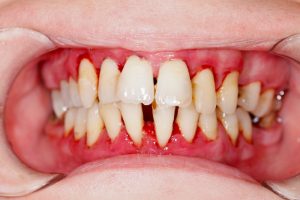
Have you heard the words “periodontitis” and “gingivitis” thrown around at your dentist’s office, but aren’t sure what they mean or what makes them different? These terms identify the different stages of one of the most common oral health problems that’s said to impact one out of two adults in the nation according to the Centers for Disease Control and Prevention, called gum disease. Read on the learn how periodontitis and gingivitis are differentiated from each other and what actions to take if you hear these words to describe your oral health.
What is Gum Disease?
Gum disease, also referred to as periodontal disease, is an oral infection that damages the gums and jawbone. It doesn’t develop overnight; in fact, it gradually progresses over time due to colonization of harmful oral bacteria as a result of poor oral hygiene. This progression consists of two stages of gum disease in West Orange—gingivitis and periodontitis.
Gingivitis
Gingivitis is the earliest stage of gum disease that’s typically marked by bleeding gums when you brush or floss your teeth and inflammation as a result of plaque and tartar accumulation. At this stage, the disease can usually be reversed as long as the bacteria are minimized with thorough oral hygiene and professional treatment.
Periodontitis
Periodontitis is the late stage of gum disease that develops when gingivitis goes left untreated. Some common symptoms are deep gum pockets filled with bacteria and pus located between the teeth, gum recession that causes teeth to look longer, and even loose or missing teeth. This stage can only be managed, not reversed.
How is Gum Disease Treated?
Once a dentist notices signs of gum disease during your routine checkup and cleaning, they’ll create a treatment plan to prevent worsening symptoms or reverse the effects of the condition. Based on the stage of the disease, they could suggest a thorough at-home oral hygiene routine or scaling and root planing (a professional deep cleaning) with antibiotic therapy.
During the deep cleaning, they’ll remove all plaque and tartar from the surface of your teeth as far down as the pockets of your gums. Then, they’ll clear the roots of the teeth, allowing the soft tissue to healthily reattach. Afterwards, they’ll place small antibiotic microspheres in the pockets of the gums to target the infection’s origin and minimize symptoms of gum disease.
It’s crucial to follow through with your dentist’s treatment plan to keep your oral health on track and prevent problems, like tooth loss, as a result of gum disease. Even though it may seem scary navigating this process, know that your dentist has the knowledge, techniques, and skills to preserve your smile and keep this common oral health problems from wreaking havoc on your life.
About the Author
Dr. Med Dawoud is the proud owner of D&G Dental as well as a highly skilled dentist with years of experience under his belt. He has specialty training in gum disease therapy procedures and is certified in the Pinhole Surgical Technique, which is able to address gum recession without using a scalpel and with minimal invasion to the mouth. He enjoys giving his patients the confidence and knowledge they need to tackle common oral health problems like gum disease. For questions or to schedule a consultation for periodontal therapy, visit D&G Dental’s website or call 973-731-2200.
